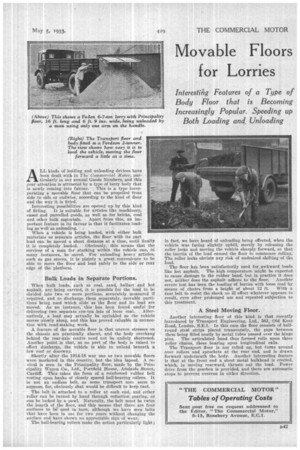Movable Floors for Lorries
Page 121

If you've noticed an error in this article please click here to report it so we can fix it.
Interesting Features of a Type of Body Floor that is Becoming Increasingly Popular. Speeding up Both Loading and. Unloading
ALL kinds of lodding and unloading devices have been dealt with in The Commercial Motor, particularly in our annual Goods Numbers, and this year attention is attracted by a type of lorry body that is newly coming into favour.' This is a type -incorporating a movable floor that can be propelled from side to side or endwise' , according to the kind of floor and the way it is fitted: Interesting possibilities are opened up by this kind of fitting. It is suitable for articles like machinery, cased and parcelled goods, as well as for bricks, coal and other bulk materials. Apart from this, an important feature in its favour is that it facilitates loading as well as unloading.
When a vehicle is being loaded, with either bulk materials or separate articles, the floor with its part load can be moved a short distance at a time, until finally it is completely loaded. Obviously, this means that the services of a man for stacking within the vehicle can, in many instances, be saved. For unloading heavy articles, such as gas stoves, it is plainly a great convenience to be able to move the floor and load safely to the side or rear edge of the platform. •
Bulk Loads in Separate Portions.
When bulk loads, such as coal, sand, ballast and hot asphalt, are being, carried, it is pbssible for the load to be divided into two or more • portions, accurately, measured if required, and to discharge them separately, movable partitions being used which slide as the floor and its load are moved. As an instance,' this has been found useful for
delivering two separate one-ton lots of loose coal, Alternatively, a load may actually be sprinkled as the vehicle moves slowly along, and this has proved valuable in connection with road-making work.
A feature of the movable floor is that uneven stresses on the chassis are practically absent, and the body overhang behind the rear-axle centre need not be unduly shortened. Another point is that, as no part of the body is raised to effect discharge, the vehicle is able to unload beneath a low roof or doorway.
Shortly after the 1914-18 war one or two movable floors were marketed in this country, but the idea lapsed. A revival is seen in the Principality floor, made by the Principality Wagon Co., Ltd., Portfield House, Adelaide Street, Cardiff. This takes the form of a reinforced rubber belt resting upon banks of closely spaced ball-bearing rollers. It is not an endless belt, as Some transport men seem to suppose, for, obviously that would be difficult to keep taut.
The belt is attached to a roller at each end, and either roller can be turned by hand through reduction gearing, or can be locked by a pawl. Naturally, the belt must be twice the length of the floor, and this means that there are four surfaces to beused in, turn, although we have seen belts that have been in use for two years without changing the surface and have shown no appreciable sign of wean
The ball-bearing rollers make the action particularly light ; in fact, we have heard of unloading being effected, when the vehicle was facing slightly uphill, merely by releasing the roller locks and moving the vehicle sharply forward, so that the inertia of the load caused the floor to commence rolling. The roller locks obviate any risk of undesired shifting of the load.
The floor has been satisfactorily used for,awkward loads like hot asphalt. The high temperature might be expected to cause damage to the rubber band, but in practice it Aloes not, neither does the asphalt adhere to the floor. Anothkr severe test has been the loading of lorries with loose coal by means of chutes from a height of about 12 ft. With a taut belt to resist the shock no ill effect whatever appears to result, even after prolonged use and repeated subjection to this treatment
A Steel Moving Floor.
Another interesting floor of this kind is that recently introduced by Transport Engineering, Ltd., 561, Old Kent Road, London, S.E.1. In this case the floor consists of halfround steel strips placed transversely, the gaps between them being filled neatly by metal tubes passed over the hinge pins. The articulated band thug formed rolls upon three roller chains, these bearing upon longitudinal rails.
The Transport floor is not rolled up, but turns around over rollers and sprockets at the rear end, and is drawn forward underneath the body. Another interesting feature is that at the front end a stout metal bulkhead is erected, which, in moving rearward, thrusts out the load. Power drive from the gearbox is provided, and there are automatic stops to prevent overrun in either direction.




























































































































































































